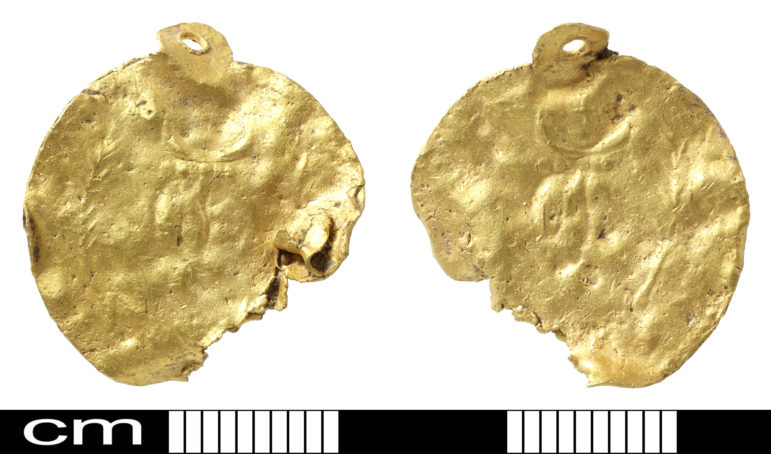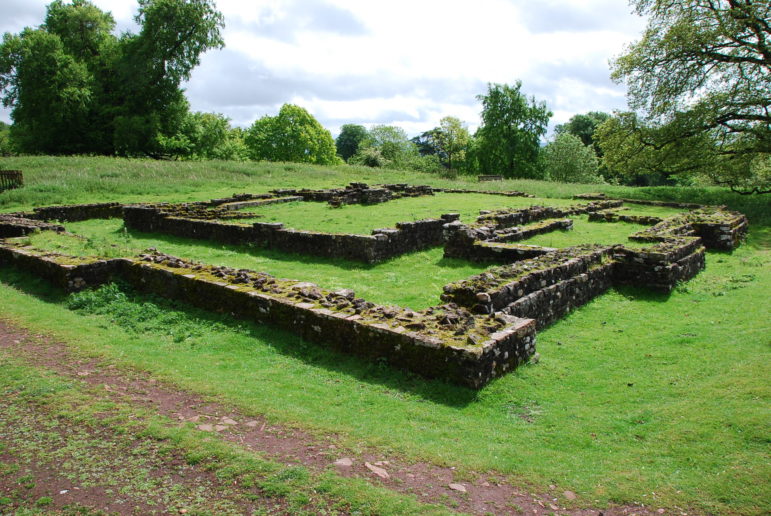DISS, Norfolk, England – On Christmas Eve in 2021, metal detectorist Nick Bateman took his device out for a spin in a local field near Diss in Norfolk, and literally struck gold: namely, a Roman earring. Bateman’s find has recently been declared “a treasure” by the Norfolk County Council and will be on loan for a future exhibit at the
Diss Museum.
Bateman
told the BBC News, “I’d done all the Christmas stuff so I thought I’d go out for a sneaky hour or two. It wasn’t the best signal in the world but I dug down three or four inches (seven to 10 cm) and saw what I thought was a gold metal bottle top, but when I cleared off the mud I realised I’d found gold and sunk to my knees in disbelief.”
Numismatist Adrian Marsden from the Norfolk Historic Environment Service reports:
“A colleague thought it was medieval as he could see a tiny cross under one of the loops. But when I looked closely I could see a laurel wreath and an eagle and that’s exactly the sort of thing you get on Roman objects. Other artefacts like this had gone down as medieval, so it does show you need to keep your wits about you when you examine these things.”

Image credit/Rights Holder: The Portable Antiquities Scheme – CC by S.A. 2.0
The find is not the only instance of Roman treasure to have been discovered in the U.K. in the last couple of years. In 2020, detectorists James Spark and Mark Didlick found a cache of 2,000-year-old Roman bronze in Ryedale in Yorkshire, including a six-inch bust of Marcus Aurelius (161 to 180 CE), and a statuette of the god Mars on horseback. It is thought that this treasure trove may have been buried as an offering to the gods.
We know that Mars was worshipped in Britain during the Roman occupation, both as an individual deity, and as a syncretic one: the Romans often conflated him with Cocidius, a tribal god who was worshipped in the north of England and the Scottish borders. His name may stem from the word for ‘red’ and there is some evidence that statues of him were red-painted.
Dedications to him can be found along Hadrian’s Wall and the Solway Estuary; there may have been a temple dedicated to him at Bewcastle. At Ebchester there is an inscription that describes him as Cocidius Vernostonus, Cocidius of the alder tree. Statuettes depict him as armed, with a sword and shield, thus it is easy to see why the Romans connected him with their own Mars, the god of war (and many other things, too, including agriculture).

Arch depicting the war god Mars flanked by two male attendants, it may have framed a cult statue of Mars Thincsus, from the shrine of Mars Thincsus at Housesteads, Clayton Museum, Chesters Roman Fort, Hadrian’s Wall – Image credit: Carole Raddato (FRANKFURT, Germany) – CC BY-SA 2.0
And it is easy to see, too, why the Romans brought their god with them to Britain: this was a military occupation of a far-flung colony and the gods of war were popular with the troops. Mars is not alone – Mithras was also popular, and there are a number of Mithraeums known to have existed in Britain.
Another tribal god, Belatucader, has also been associated with Mars. He appears in both Ireland and Wales, and his name has been translated as ‘the fair shining one.’ As with Cocidius, there are inscriptions found along Hadrian’s Wall which are dedicated to him. Lenus is another cognate.
A little care must be exercised here to not make the assumption that gods like Cocidius were there first. Roman troops may have imported both deities, taking Celtic gods from the tribes of northern Europe into Britain (Coventina, in Carrawburgh in Northumberland is thought to be one of these).
We find dedications to Mars, syncretically, throughout Britain:
To the god Mars Alator Dum(…) Censorinus, son of Gemellus, willingly and deservedly fulfilled his vow.
To Mars Toutatis, Tiberius Claudius Primus, freedman of Attius, willingly and deservedly fulfilled his vow.
The above inscriptions come from Barkway in the Chilterns, where a Roman treasure hoard was discovered in the 1700s and where it is likely that a Roman temple to Mars once stood.
This is not the only example: a number of syncretic temples have been discovered, such as the one to Mars Oculus at Caerwent in South Wales, or the probable site of a temple at Cockersand in Lancashire, where two silver statuettes dedicated to Mars Donotus and Mars Odontis where discovered.
Authorities believe that these were forms of Mars/Nodens, as above. Nodens’ main temple is on the shores of the river Severn, at Lydney in Gloucestershire, it is an extensive site, built in the 4th century.
Unlike many Roman temples in the U.K., it is not based on the structure of a basilica but has two side chapels and it has been suggested (although without a great deal of evidence) that it was used as an incunabulum, a place for divinatory dreaming. It is certainly associated with dogs, which across the Roman world are found at temples of healing. Votive offerings representing parts of the body have been found there, too – further evidence that this was a healing shrine.

Romano-Celtic temple complex for Nodens/Mars at Lydney Park in Gloucestershire – Image credit: Jeff Collins – CC BY-SA 2.0
There was a major healing temple dedicated to Mars Lenus on the Continent, at what is now Trier. It may seem curious to us that Mars in the Celtic world seems to have become so linked to healing deities since he is a god of war, but the Romans regarded him as only warlike because he is a protector, and perhaps healing may be seen as the other side of this coin of war, an aspect of protection.
Curse tablets have been found at Lydney, including one inscribed by a man named Silvianus – like many such tablets, it curses the man who stole it. We know where the ring ended up, too, for it was found in Silchester in the 1700s. But it has a more lasting and oblique fame: the archaeologist who excavated Lydney, the well-known Sir Mortimer Wheeler, consulted J.R.R. Tolkien, who was intrigued by Nodens and wrote a philological essay in 1932 discussing the origins of the name. It has been suggested that Silvianus’ stolen ring then metamorphosed into the ‘one ring’ in Tolkien’s most famous work since the author is known to have drawn a great deal of his inspiration from the history and landscape of Britain.



